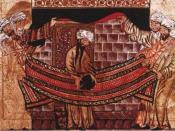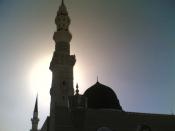The selected readings in "The Veil and the Male Elite" shed a different perspective on reasons of the descending of the veil. Mernissi's accurate knowledge in the field as well as continuous use of substantial support for her reasoning as to why the veil was descended appeals to me more than anything I have read before. The veil or hijab is basically a head wrapping that covers the women's face as well as hair only showing the eyes. While others may try to rationalize the wisdom behind the veil Mernissi's likes to describe it as a "draconian sentence" on many women. The veil was descended to protect people's privacy in a very open society as well as to protect the women from the men.
I believe that it is of relevant importance to talk about how the veil first came into place in Islamic society before it is appropriate to analyze the reason for its decent.
The story begins with the prophet wedding Zaynab Bint Jahsh and was charged with inviting a large number of people to the wedding in Medina. Many groups of people attended the wedding, ate their meals and departed however a group of people lingered behind involved in their conversations. The prophet was anxious to wed his new wife and with the present of the ill-mannered guests he was getting upset. Muhammad was too polite and mannered to ask the gentlemen to leave so he went to visit one of his other wives to tell her his troubles. Eventually the guests left and as he was about to enter Zaynab's room a "sitr" and the verse of "hejab" descended at that time. This was the first time the concept of a barrier to separate originally two men was adapted in to the idea of "hejab"
Mernissi points out that the "hejab" used in year 5 of "hijra" had a different symbolic and materialistic meaning than it does now in the 20th centaury. When the city of Medina was under siege the village was forced to harbor over 3,000 soldiers to protect it. The direct result of this was the fact that it was impossible for women to walk around the city without being harassed. This was unfortunately true even for the wives of Prophet Muhammad. The "aya" of Hejab included "a-not causing annoyance to the prophet, b- nor marrying his wives after his death" based on rumors that had been circulating about men who wanted the marry his wives after his death. There was also another instance where a man by the name of "Uyayna" actually had the audacity to ask the prophet if he could switch one of his wives with him. I think this is where the concept of "sitr" and "satr" become extremely important to stress on.
As time went on women were being harassed at a much more frequent and alarming manner. A large number of female slaves were basically rapped in Medina, one would guess that the men felt that they had to right to intercept the route of any women and force themselves upon them. This is the mirroring of pre-Islamic practices. As Allah saw this Islam banned owners of slaves of prostituting them. Islam didn't stop there it banned the existence of slaves.
The hejab was then looked upon as a response to the sexual aggression that was taking place. The writer argues that it is an aggression against the female body declaring the whole thing as "awra", literally nudity. The hejab was also a must because women were harassed based on social class were not physically distinguishable when covered since the appearance of clothes can be quite misleading. One might be able to see the recourse of the hejab if the significance of "zina" is seen the very thing that Islam was trying to fight against.
With hejab in place the society would be divided into two categories: Free women, against whom any form of violence is forbidden and women slaves that can literally be raped. Muhammad was trapped he was in a position where he had to make a decision either to wait for his new source of power (god and his religion to become rooted in the people's mentality) or he could "re-activate the tribe as a police force in the city" Picking the second option was the wisest because it secures the city immediately since the first method would've been more time consuming.
The reasons for the descending of the veil were to develop certain parameters in a society that lacked any. When Muhammad came out and asked the women to wear the veil he was attempting to right a highly unethical situation against the women of his tribe. I think Mernissi would agree with me however that the Hejab wasn't intended to be applied in our modern day practical life because as civilized as we are now the concepts and norms have changed enough that women aren't periodically rapped because they are of a lower class. Muhammad reacted unusually to a rather unusual problem. The descending of the veil seems justified in the matter of protecting the women in Medina from the assaulting men.


